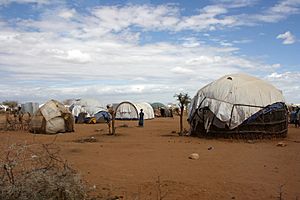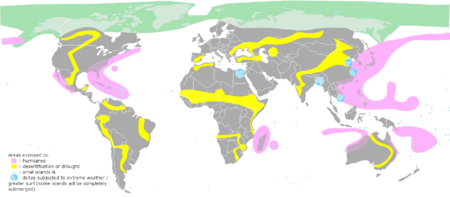Environmental migrant facts for kids

Environmental migrants are people who have to leave their homes. They move because of big changes to their local environment. These changes make it hard for them to live or earn money. Examples include more droughts, land turning into desert, rising sea levels, or changes in normal weather patterns like monsoons.
There isn't one perfect definition for environmental migration. But it's becoming a more important idea. Experts are trying to understand how climate change and other environmental problems, like cutting down too many trees (deforestation) or using too many resources, affect people.
You might hear different names for these people. Some common ones are "climate migrant" or "environmental refugee." Other terms include "ecological refugee," "forced environmental migrant," or "environmentally displaced person." These names all mean similar things, but people still debate which one is best.
Contents
What are Environmental Migrants?
Most people who move because of environmental problems don't go very far. They often stay within their own country. Also, they are not leaving because they are afraid of being treated badly or because of war.
The legal definition of a refugee was set in 1951. It was later made broader. But people who leave their homes because of environmental changes still don't get the same legal help as refugees.
The idea of an "environmental refugee" was first suggested in 1976 by Lester Brown. The International Organization for Migration (IOM) has a helpful definition for environmental migrants: "Environmental migrants are people or groups who, because of strong reasons like sudden or slow changes in the environment that harm their lives, have to leave their usual homes. They might choose to move temporarily or permanently, either within their own country or to another country."
Climate migrants are a special group of environmental migrants. They are forced to move because of changes in the natural environment linked to climate change. These changes include rising sea levels, very bad extreme weather events, and droughts or not enough water.
Types of Environmental Migrants
The International Organisation for Migration (IOM) describes three main types of environmental migrants:
Environmental Emergency Migrants
These are people who leave their homes for a short time because of a sudden environmental disaster.
- Example: Someone who has to leave quickly because of a hurricane, tsunami, or earthquake. They might go back once the danger passes.
Environmental Forced Migrants
These people have to leave their homes because environmental conditions get worse over time.
- Example: Someone forced to move because of slow changes like deforestation or their coast wearing away. In India, people from Satabhaya village had to move because the sea was taking their homes and making their farmland salty. In Nepal, many villages in the Chure regions have moved due to a lack of water.
Environmental Motivated Migrants
These people choose to leave to avoid future problems. They see environmental changes happening and decide to move before things get too bad.
- Example: Someone who moves because their crops aren't growing well anymore due to land turning into desert. Sometimes, people move for economic reasons, but these are often linked to environmental problems that make it hard to earn a living.
How Many Environmental Migrants Are There?

Over the years, many people have tried to count how many environmental migrants there are.
In 1988, Jodi Jacobson said there were already about 10 million "Environmental Refugees." She thought that if sea levels rose a lot, environmental refugees could be six times more numerous than political refugees. By 1989, Mustafa Tolba, from the United Nations Environment Programme, said that "as many as 50 million people could become environmental refugees" if the world didn't work towards sustainable development.
In the 1990s, a British environmentalist named Norman Myers became well-known for his estimates. He said there were 25 million environmental refugees in the mid-1990s. He also thought this number could double by 2010. He even suggested it could reach 200 million by 2050. Myers believed that things like land turning into desert, lack of water, and salty farmland would cause people to move. He predicted large numbers of people moving in countries like China, India, and Bangladesh. More recently, Myers has suggested the number could be as high as 250 million by 2050.
Norman Myers' work is often mentioned, but some experts have questioned his numbers. For example, Vikram Kolmannskog said Myers' work can be "hard to check." Myers himself admitted his figures were based on "heroic guesses." Other researchers, like Black, have said there isn't much scientific proof that the world is "filling up with environmental refugees."
It's important to remember that many people affected by environmental changes move within their own country. They become internal refugees rather than crossing international borders.
Environmental Migrants in Culture
Books and Movies
The idea of people moving because of environmental problems has been in popular culture for a long time.
- The Grapes of Wrath, a famous novel from 1939 by John Steinbeck, tells the story of a family who had to leave their farm during the Dust Bowl drought.
Documentary Films
Several documentaries have explored the topic of environmental migration:
- Eco Migrants: The Case of Bhola Island (2013)
- Refugees of the Blue Planet (2006)
- The Land Between (2014)
See also
 In Spanish: Refugiado ambiental para niños
In Spanish: Refugiado ambiental para niños
- Effects of climate change
- Forced displacement
- Managed retreat
- United Nations High Commissioner for Refugees
- Water scarcity

